|
From The Lure of the Litchfield Hills magazine, June, 1949
I have attempted to find the publisher to ascertain the copyright
standing with no success. If someone holds this copyright and
objects to the stories appearance on this web site, please let
me know and I will take it off the site.

Shepaug Epic

A dream railroad that came true in a valley of titanic decisions—
By Alfred S. Dillistin
"Dreamers are the architects of greatness, hearing
the voice of destiny calling from the unknown they peer beyond
the mists of doubt and pierce the walls of unborn time."
Herbert Kaufman.
The writing of this tribute to a man, a river and a railroad
was truly a labor of love, hence a joy, largely due to the hearty
cooperation of dwellers along the Shepaug River and railroad,
together with The New Haven Railroad, Allyn Fuller, Arthur H.
Wilcox, Walter P. Lake, Edward Beers, William Rowe, Daisy Stiles
Hicock, and Charlotte Shepard.
The author pays them one and all a debt of gratitude.
A pen picture will help us visualize our heroes home town of
Litchfield, Connecticut before the golden dawn of Shepaug Railroad
days. In the very heart of our Connecticut Litchfield Hills, 1100
ft. above sea level, reposes our charming hostess. Her humble
cots and palatial mansions together with her four churches are
shaded by ancient wine glass elms, and hoary oaks and in autumn
her maples carnival in a riot of reds and oranges.
Fate placed our mistress of the hills at the crossroads of
the New Haven and Albany; and the Hartford and New York turnpikes
and her Mansion House and Phelps Tavern entertained many celebrities.
Here is an ad of 1829—"Litchfield and Norwalk Stagecoach.
Leaving Tues., Thurs. and Sat., 3 A.M. via New Milford to Danbury
Hotel for the night; leaving early the next morning and arriving
in Norwalk for the New York steamboat. Fare $3.25."
In Civil war days Litchfield had a station at East Litchfield
on the Naugatuck Valley R.R. 4 miles east; some sprint for the
tardy commuter in his mad rush for the 8:30! Dwellers along this
dirt road of countless thank-you-mam's, were often awakened by
creaking wheels and straining traces of the belated stage struggling
to mount the 500 ft. hill crest.
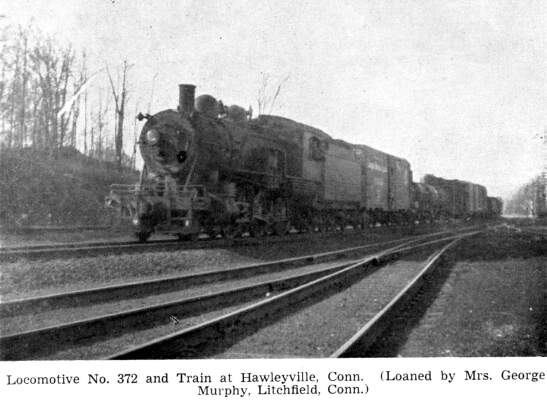 And
O what winters of adventure! In November 1779 John Cotton Smith,
Connecticut Governor left his Sharon home for New Haven, he says—"We
found the road badly drifted before we reached Ellsworth and had
to leave our sleigh and pursue our journey on horse back. It was
dark before we reached Litchfield and the snow ladened wind was
piercing cold and cut into our faces like iron filings. We were
almost blinded and bewildered. On Wednesday the lower windows
of many Litchfield houses were hidden beneath great drifts and
only rising wreaths of smoke told that life existed within. At
9 A.M. we climbed out of the second story windows upon the hard
crust and started off with snow shoes and a roll fastened to our
backs." And
O what winters of adventure! In November 1779 John Cotton Smith,
Connecticut Governor left his Sharon home for New Haven, he says—"We
found the road badly drifted before we reached Ellsworth and had
to leave our sleigh and pursue our journey on horse back. It was
dark before we reached Litchfield and the snow ladened wind was
piercing cold and cut into our faces like iron filings. We were
almost blinded and bewildered. On Wednesday the lower windows
of many Litchfield houses were hidden beneath great drifts and
only rising wreaths of smoke told that life existed within. At
9 A.M. we climbed out of the second story windows upon the hard
crust and started off with snow shoes and a roll fastened to our
backs."
And O what summers and what air! Indeed it was these twain
glories of our belle of the hills that won and clinched the affections
of her lover our hero, Major Edwin McNeill.
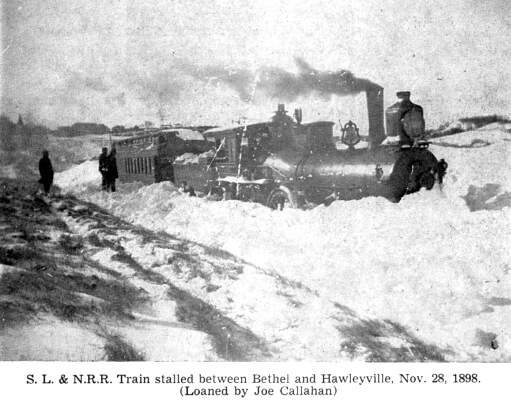 Of
Scotch ancestry Edwin MeNeill bore all the earmarks of that indomitable
race. A civil-engineer by profession, in 1863 he returned from
the Civil War to Litchfield air and sunshine for rest and recuperation
and he found them. On long summer days he dreamed and dreamed
of direct railroad connections with New York City and the Shepaug
R.R. to be, was his brain child and favored son. Enterprises of
great moment are said to be "the shadows of great men."
Truly the Shepaug R.R. was the shadow of Edwin McNeill. Good fortune
had blessed him with good training, long years of experience and
an iron will; when Edwin McNeill saw a star, after that it was
victory or death. Of
Scotch ancestry Edwin MeNeill bore all the earmarks of that indomitable
race. A civil-engineer by profession, in 1863 he returned from
the Civil War to Litchfield air and sunshine for rest and recuperation
and he found them. On long summer days he dreamed and dreamed
of direct railroad connections with New York City and the Shepaug
R.R. to be, was his brain child and favored son. Enterprises of
great moment are said to be "the shadows of great men."
Truly the Shepaug R.R. was the shadow of Edwin McNeill. Good fortune
had blessed him with good training, long years of experience and
an iron will; when Edwin McNeill saw a star, after that it was
victory or death.
With the zest of conquerors he and a few friends, believing
in their hero and his mission, surveyed the 32 miles south to
Hawleyville thru the Shepaug and Pond Brook valleys, facing unbelievable
odds and even shotgun threats by objecting farmers. The Major
answered "come on boys, I've smelt powder before." Some
objectors believed the snorting, fire spitting iron horse was
of the devil, others feared sparks would fire their crops and
buildings, and others said the R.R. would flood the valley with
foreigners and smart city alacs bent on relieving them of their
hard earned cash.
However, in 1866, the state chartered the building of the Shepaug
Valley R.R. Then a 3-year struggle for organization and finances
set in, terminating in its incorporation in 1869. The Hon. J.
Deming Perkins was chosen president, Henry R. Colt, treasurer
and Edwin McNeill, superintendent.
 On
Oct. 12, 1870 construction started at Hawleyville reaching Roxbury
in Oct. 1871. Another construction gang started south from Litchfield.
The first three locomotives were named—Shepaug, Weatinaug
and Waramaug, each weighing 30 tons. On
Oct. 12, 1870 construction started at Hawleyville reaching Roxbury
in Oct. 1871. Another construction gang started south from Litchfield.
The first three locomotives were named—Shepaug, Weatinaug
and Waramaug, each weighing 30 tons.
On the morning of January 1st, 1872, the Waramaug's whistle
brought out the whole town to welcome Litchfield's first train.
Regular service started Jan. 11th, the morning train leaving 8:30
and arriving in Hawleyville at 11:30, better than 10 miles per
hour, whew!
At Hawleyville the Shepaug intersected the Housatonic R.R. running
between Bridgeport and Pittsfield, Mass. As steamboat excursions
from Bridgeport to Long Island Sound resorts and Coney Island
were popular then, the Shepaug R.R. did a thriving summer business,
greatly encouraging its projectors. Then too, Bantam industries
were growing, together with New Preston marble and Mine Hill granite
quarries and iron furnaces, and the Silicon Mill at Roxbury Falls;
all needed supplies and found a ready outlet on the R.R. for their
products. Add to these the traffic in coal, lumber, grain and
foods, together with the U. S. Mansion House in Litchfield drawing
throngs of New Yorkers and then we learn why the Shepaug R.R.
and its alluring river bride, became the life of the valley meandering
together in and out and around great mountain promontories.
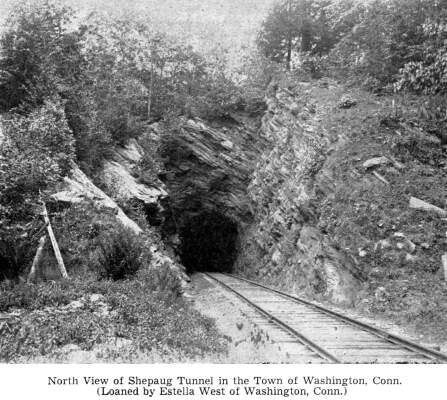 George
J. Flynn says, "The Shepaug is one of the most beautiful
rural railways in the U.S. Its trains rattle their hocks as they
lumber thru fields and woods of unsurpassed beauty." George
J. Flynn says, "The Shepaug is one of the most beautiful
rural railways in the U.S. Its trains rattle their hocks as they
lumber thru fields and woods of unsurpassed beauty."
In July 1872 a 6-mile extension was added between Hawleyville
and Bethel connecting with the Danbury and Norwalk R.R. Locomotive
No. 372 is at the Litchfield station and engineer Robert Baird
has kindly asked the reader and writer to climb into the cab where
we can review the glories of the Shepaug and Pond Brook valleys
as a trainman sees them.
Conductor Frank Herbst cries "all aboard for Hawleyville
and way stations" and we are off. We soon catch glimpses
of Bantam Lake teeming with vacationists. The lake's outlet, the
Bantam River, drops 100 ft. the first mile and once a succession
of 6 ponds and mills graced these rushing waters. At Morris Station
the valley narrows darkened by evergreens and mountain walls,
the R.R., river and highway vie for passage. We skirt the base
of Mt. Tom. 1325 ft. alt. From its tower one sees a most graphic
view of the Shepaug valley, truly Alpine. Access is gained thru
Mt. Tom State Park at Woodsville on Route No. 25. Just beyond
Romford depot surprises await us as the Bantam tributary joins
the Shepaug river doubling its volume. At this point our R.R.
groom meets Miss Shepaug, his blushing river bride, fresh from
Cornwall hills and saintly Goshen. They promise allegiance, but
alas their marital troubles begin at once. Never did an alcoholic
crazed with rum stage such a series of reeling staggers and gyrating
meanders. Our groom strains and groans, and weary of his bride's
connubial contortions at her oxbows and sallies, shoots off alone
on a straight and narrow path. However the estrangement isn't
for long, and like all good husbands he takes his medicine like
a man. If we will review our U. S. Survey Map we shall see our
river bride is blameless and marvel at her graceful bends as she
rambles thru, over and around the most rugged terrain to be found
anywhere in our Conn. hills. The Muir Woods R.R. in California
boasts of being the crookedest R.R. in the U.S. and the Shepaug
comes 2nd with its 195 curves in 38 miles. Having hiked most of
its right of way I know this figure is conservative. The 38 miles
of track are nearly twice the airline milage.
 Edward
Seeley crossed the Atlantic twice and was never seasick until
his 1st trip on the crooked Shepaug. Others say the Shepaug, in
its effort to please, rendered all the sensations of the fox trot,
goose step and now and then one of Edwin McNeill's own highland
flings to boot. We have already passed New Preston station and
engineer Baird whistles Woo, Woo, Woo, Woo, for Washington depot.
The Gunnery school for boys is located here enrolling 123 and
many graduates have been outstanding in their calling. The Platt
Museum in the Gunn Memorial Library has a most interesting collection
of Colonial and Indian relics and "the public is always welcome",
says the efficient librarian, Mrs. Warren E. Greene. Edward
Seeley crossed the Atlantic twice and was never seasick until
his 1st trip on the crooked Shepaug. Others say the Shepaug, in
its effort to please, rendered all the sensations of the fox trot,
goose step and now and then one of Edwin McNeill's own highland
flings to boot. We have already passed New Preston station and
engineer Baird whistles Woo, Woo, Woo, Woo, for Washington depot.
The Gunnery school for boys is located here enrolling 123 and
many graduates have been outstanding in their calling. The Platt
Museum in the Gunn Memorial Library has a most interesting collection
of Colonial and Indian relics and "the public is always welcome",
says the efficient librarian, Mrs. Warren E. Greene.
Three miles south of the depot our river bride has a seizure
and detours 2 miles around her largest oxbow, leaving her lover
to cut his way alone thru a 495 ft. granite tunnel. This section
is known as Steep Rock Reservation, a 600 acre game forest and
park, the gift of Hon. Ehrich H. Rossiter to the town. Steep Rock
cliff rising abruptly from the river 300 ft. is stately and impressive.
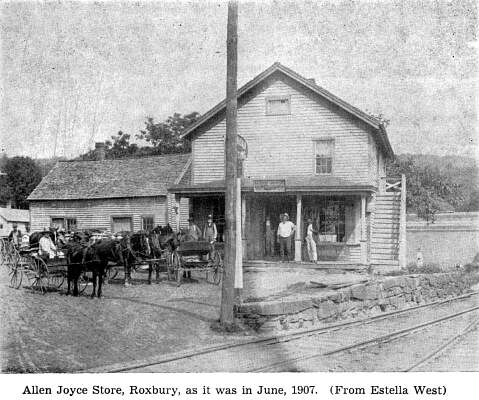 Emerging
from the tunnel we find our river bride has had a change of heart,
contrition and reunion follow as we approach Judds Bridge and
merrily we roll along to the rhythm of our rivers song Emerging
from the tunnel we find our river bride has had a change of heart,
contrition and reunion follow as we approach Judds Bridge and
merrily we roll along to the rhythm of our rivers song
I slip, I slide, I gloom, I glance Among my skimming swallows,
I make the netted sunbeams dance Against my sandy shallows.
I wind about and in and out With here a blossom sailing,
And here and there a lusty trout And here and there a greyling.
Tennyson.
That's the spirit! O the jolly mirth of our maiden rivers frolicing
down the steps of the Litchfield Hills. They have slipped the
belt, letting the old world spin on in its woes and wars, as they
rejoice and praise God for life's music and endless surprises.
If we don't burst out, fling our caps in air, and hurrah boys
with our singing rivers as they turn the wheels of industry, we
are in the wrong place and should change our jobs, our philosophy,
or our doctor.
"Life is not a disease to be treated with pills, nor
an affliction to be shirked, but an adventure to be savored and
enjoyed here and now. Life is the highest imaginable experience,
an inner grace and joy triumphing over fate."
H. L. Mencken.
For 3 miles our train skirts the base of Mine Hill 900 ft.
alt., once a humming hive of activities in its iron shafts, furnaces
and granite quarries. In Roxbury Center Col.Seth Warner's monument
and the Hodge Memorial Library are Mine Hill granite. The retaining
walls of the New Haven R.R. elevated 4 miles thru Bridgeport are
Mine Hill granite.
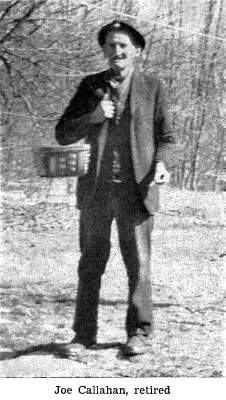 An
8 ft. vein of siderite spathic iron ore, one mile long crosses,
Mine Hill, horizontal shafts penetrate it. This mine was opened
in 1750 when silver was discovered and a 150 ft. shaft sunk. Then
iron was found and The American Smelting Co. spent over a million
dollars developing a great industry. Furnaces were operated 42
years yielding an average of 10 tons of pig iron daily. Operations
ceased in the 1870's. Iron originally was one of the rarest of
earth's minerals; all our great deposits are of meteoric origin,
goodwill gifts from fellow stars. Connecticut has often been the
target of whole galaxies of shooting stars. While crossing a fallow
field on Sharon Mt. 1300 ft. alt. I found a 7 lb. meteorite, a
nugget of red hematite iron ore. Iron meteorites average 90% pure
iron, when arriving are luminous in frictional heat, travel at
estimated speeds of 10 to 50 miles per second and bury themselves
2 to 3 feet in earth. Mine Hill ore is yellowish brown and differs
from red hematite ore of northwestern Connecticut and yellow limonite
ore, in that steel was made from it in one operation from the
pig. It was highly prized in the making of surgical instruments
because of its great tenacity. Columbia University once taught
mining at Mine Hill and its infinite variety of minerals has always
attracted mineralogists. An
8 ft. vein of siderite spathic iron ore, one mile long crosses,
Mine Hill, horizontal shafts penetrate it. This mine was opened
in 1750 when silver was discovered and a 150 ft. shaft sunk. Then
iron was found and The American Smelting Co. spent over a million
dollars developing a great industry. Furnaces were operated 42
years yielding an average of 10 tons of pig iron daily. Operations
ceased in the 1870's. Iron originally was one of the rarest of
earth's minerals; all our great deposits are of meteoric origin,
goodwill gifts from fellow stars. Connecticut has often been the
target of whole galaxies of shooting stars. While crossing a fallow
field on Sharon Mt. 1300 ft. alt. I found a 7 lb. meteorite, a
nugget of red hematite iron ore. Iron meteorites average 90% pure
iron, when arriving are luminous in frictional heat, travel at
estimated speeds of 10 to 50 miles per second and bury themselves
2 to 3 feet in earth. Mine Hill ore is yellowish brown and differs
from red hematite ore of northwestern Connecticut and yellow limonite
ore, in that steel was made from it in one operation from the
pig. It was highly prized in the making of surgical instruments
because of its great tenacity. Columbia University once taught
mining at Mine Hill and its infinite variety of minerals has always
attracted mineralogists.
Below Roxbury station the valley narrows and our honeymooners
steal many a fond embrace huddling for passage. Alas as the honeymoon
wanes grooms tend to become forgotten men. What a fate!
Our hero will soon need all the patience he can muster, his
lovers increasing speed predicts another of her seizures. Suddenly
in witching grimaces she drops 60 ft. in a series of cascades
in a narrow half mile granite gorge, amid churning foam and spray
and a deafening roar, leaving her lover high and dry on a rock
shelf notched in Hut Hill.
These are the famed Roxbury Falls, at their best in spring
when they can be described in superlatives only. A highway bridge
crosses the river here where once the depot, Silicon Mill, burned
in 1908, while, hat shop, store and post office once enlivened
these solitudes. Silicon is quartz stone, it was drawn from the
mine one mile east, kiln burned, crushed and ground to powder
by water power, and shipped in barrels via rail to manufacturers
of sand soap, paint, sandpaper and other abrasives.
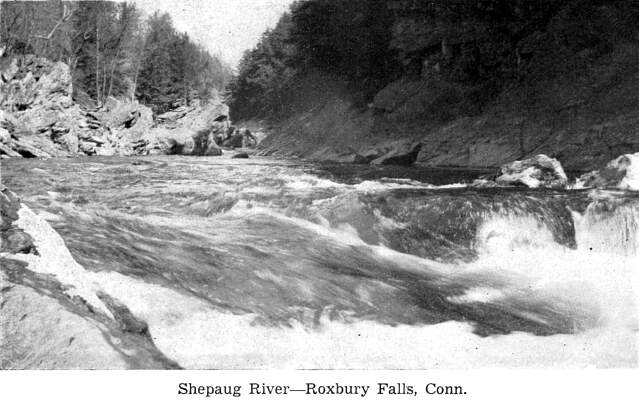 Attention
anglers! "The rare shad that triumphed over these falls was
a real sportsman'' says William Cothern. "In 1860 Thomas
Tyrell owner of the Silicon Mill using a shad seine captured a
17¼ lb. trout, 37½ inches long; witnessed by several
persons." Whew! Attention
anglers! "The rare shad that triumphed over these falls was
a real sportsman'' says William Cothern. "In 1860 Thomas
Tyrell owner of the Silicon Mill using a shad seine captured a
17¼ lb. trout, 37½ inches long; witnessed by several
persons." Whew!
The last 4 miles of the nuptial trip is most endearing as our
lovers envision parting at the mingling of Shepaug and Housatonic
waters. At this confluence our train crosses the 428 ft. steel
trestle bridging the Housatonic in the most primitive section
of its 125 mile course. Emerald mountain walls and a narrow strip
of sky and water are our only companions. Not a house to be seen
and the nearest store is 5 miles distant, solitude impregnates
the very air.
The "chuck I chuck"—"I think I can"
of our locomotive is heard for 4 more miles as it winds and climbs
Pond Brook shores. Suddenly she tops the summit quickening her
tempo and song to "I knew I could"—"I knew
I could." Locomotives are quite human, some days they teem
with zest and power, others they are obdurate and refractory,
but I have yet to meet the engineer who does not humor, respect,
yea love his faithful pal and comrade in toil.
Paddy drove the New Haven's mightiest and scorned electrics
as effeminate. "Ah", said Paddy, "give me the good
old fire eating, smoke spitting locomotive, and a fireman that
will give her a shovelful at every telegraph pole, and by the
shades of St. Patrick I'll shoot her in on time or me name ain't
Paddy Kerns." That's the "real stuff" Paddy, may
heaven rest your soul.
"Life is like a mountain railway,
Be an engineer that's brave.
We must make the run successful!
From the cradle to the grave.
Watch the fills, the grades, the tunnels,
Never falter, never fail,
Keep your hand upon the throttle
And your eye upon the rail."
M. E. Abbey
The Indians called the Shepaug, including the west branch and
east branch, now known as, the Bantam River "Mashapaug"
meaning "large pond river". The Bantam river tributary
flows into and out of Bantam Lake the "large pond'' of Indian
lore and largest natural lake in Connecticut.
The Shepaug has been called a homey valley because of its intimate
associations. Closely hemmed by cliffs and precipitous hills the
R.R. crosses narrow plains and trespasses as it were, thru the
very yards of valley folk. I have hiked sections of the 15 large
Housatonic tributaries in Connecticut, the Shepaug is by far the
most picturesque viewed from the R.R. right of way.
Joe Callaghan, may his tribe increase, a R.R. veteran, entertained
me in his Mine Hill home and guided me to the quarries and lower
furnace, which I found the best preserved of all Connecticut furnaces
due to its sawed and squared granite block construction. It rose
40 ft. in air as plumb as when its last charge cooled three generations
ago.
"Indeed I was not the only child", said Joe, "first
came Connie then William, Michael, John, Dennis, James, Joseph,
Robert, Mary and last came Luke." Nine boys and Mary a heroine
by birthright! "We nine boys loved baseball and formed a
nine with sweaters lettered Callaghan. When the old man left Ireland
his name was O'Callaghan, he threw the O in the green Atlantic
and it's been just plain Callaghan ever since." Long live
the Callaghans!
Once in the dear dead days not quite beyond recall, when first
I hiked the Shepaug, its endless curves were a continual feast
of surprises, the day was far spent when the Mine Hill monolith
came in view haloed in the setting sun. North of the highway bridge
lay the rivers largest flood plain acorn and tobacco field and
a graying barn in the distance. Birds were contending for willow
and alder perches and a lone wood thrush, that renown flutist,
was defending his title as dean of master musicians, a benediction
in melody at the close of another day of golden opportunities.
I felt at home and one with this tranquil scene, altho a stranger
knowing not a soul in town.
"The world is full of homesick
travelers, each of whom is in love
with a place he has never seen.
Hemmed in by the hills, it may be
a little town, he only knows he will
be sick for home until he finds it."
Odell Shepard.
A retreat, if only for a day, to the hills and silent places
I-ends wings to petty cares and even life's great tragedies pale
and wither in the sublime presence of infinite beauty.
Once in a while we meet a dynamic personality, a human power
house of faith, hope and courage, whose countenance radiates an
inner glow transcending fear and putting prophets of doom to shame.
We instinctively love such bundles of sunshine, they are fighting
life's battles and winning and so can you and I. To be a pupil
in Natures school is every persons privilege. To be a scholar
is man's highest goal.
Night was drawing the shades one by one when it dawned on me
that I too needed a perch for the night and stopped at a riverside
cottage to ask the location of a tourists home and found there
wasn't one in town, what should I do? Visions of that graying
barn and hayloft danced in my head. While I had seen no church
spires I learned their founder had preceded me on the Roxbury
Road. Believe it or not, those two gracious ladies, sensing my
plight, offered a stranger shelter provided "I was willing
to sleep on a cot beside the organ in the parlor." Willing?
O the sweet repose, after hiking miles in mountain air and sunshine,
of a cot, hurriedly brought from the attic and made up by loving
hands of kindly hospitality. Raised pancakes smothered in butter
and syrup graced our morning meal and then I took leave of my
friends and hit the rails north. Whenever I recall those benevolent
sisters I am reminded of the words of a fellow traveler "In
as much as ye have done it unto one of the least of these my brethern,
ye have done it unto me."
The Shepaug Valley Railroad was reorganized in 1873 and again
in 1878 and renamed The Shepaug Litchfield and Northern. A parlor
car was purchased finished in quartered oak and blue upholstery
making daily trips to N. Y. City 100.41 miles via Bethel and Norwalk,
in 3 hours and 20 minutes.
I learned of no collisions on the Shepaug, few maimings and
only 3 deaths, due to derailment, a record Shepaug R.R. fans may
well glory in.
Among the pleasantest memories of my research were the two
days spent in Litchfield with R.R. men and old timers. Engineer
Eugene Meramble, 83, is the proud owner of a diamond studded gold
pin and Golden R.R. Pass, gifts of the New Haven R.R. in honor
of Gene's 50 years of faithful service. He recalled the "good
old days" when Litchfield, Bantam and Washington each shipped
a carload of milk daily, and he engineered trains of 20 car loads
of ice from the great store houses at Bantam Lake. He had seen
100 men at work in Mine Hill quarries and train loads of granite
on the mile long siding. Gene said—"had exports continued
the Shepaug would still be operating."
I sat by the bedside of Mrs. Ida Gibbs in her 90th year and
a lady R.R. fan at that, bless her heart, I could have hugged
her once, yea twice! The dear old Shepaug was her first love;
as she walked the track to school a whole colony of bobolinks
were often perched on R.R. telegraph wires, in formations suggesting
notes on the music staff. Their cheerful melody in song"Bobolink,
Bobolink, Speck, Spank, Spenk," seemed a welcoming tribute
to the infant R.R. There was a touch of sadness, in our farewell
as Mother Gibbs spoke of her "husband's passing and my boy
is 3000 miles west, and now they have taken my Shepaug I'm all
alone, O how I miss the trains and bells and whistles of happy
yesterdays."
Mr. Crutch an old timer unearthed a tale long forgotten. One
fateful day a loaded passenger train left Hawleyville for Litchfield
and way stations that were no more, at least the engineer failed
to see them, ignoring one by one the 11 scheduled stops, with
impunity. The conductor and passengers were in panic, train sickness
epidemic, and women swooned as the speeding train negotiated the
Shepaug's own parabolic curves. Prayers were offered, pending
doom was graven in faces lest they bypass Litchfield terminal
and fetch up somewhere in the Goshen Hills.
Prayers were surely answered as the train slowed to a halt
at the lines end. The irate conductor, in stitches, rushed forward
and was greeted by the engineer's beaming smiles and balmy spirits
in gleeful elation, having taken at Hawleyville an extra nip of
the jug that inebriates to cheer his flagging spirits. The dispatcher
made up a special, the patrons got a free ride home, but the engineer
never got a diamond studded gold pin notwithstanding his distinguished
service.
When I left town I passed the county jail, insignificant viewed
from without, indeed the smallest jail I ever saw and learned
there need be no rush for reservations as there are still available
vacancies.
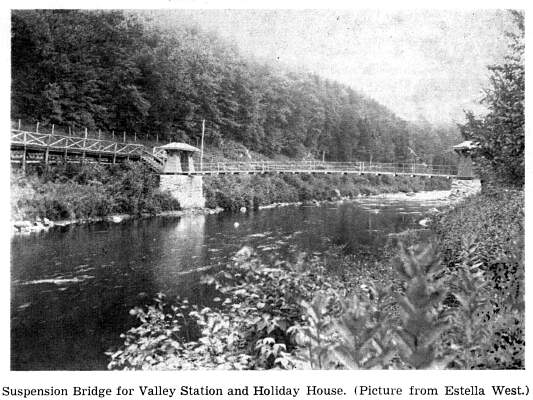 The
New Haven R.R. gained control of the Shepaug in 1898 and henceforth
it was called the Shepaug Division. In 1872 the Shepaug employed
50 men. In 1948 the number had dropped to 14. Engineer Robert
Baird, Conductor Frank J. Herbst, Brakeman Henry R. Johnson and
Flagman Ralph Spalding had been with the R.R. off and on 40 years.
These men together with Fireman Joe Wood and Baggageman Garrett
Sullivan were the honored crew of the Shepaug's last train. The
Bethel extension was discontinued June 11, 1911. The public was
exceedingly R.R. conscious long after the advent of the auto.
At the early age of 45 in 1917 our R.R. groom developed a hectic
tinge, and lost his bloom when the auto came into general use
in the 1920's. A gasoline coach was operated a short time but
traffic dwindled and the last run was made April 27, 1930 and
freight was cut to tri-weekly trips. The
New Haven R.R. gained control of the Shepaug in 1898 and henceforth
it was called the Shepaug Division. In 1872 the Shepaug employed
50 men. In 1948 the number had dropped to 14. Engineer Robert
Baird, Conductor Frank J. Herbst, Brakeman Henry R. Johnson and
Flagman Ralph Spalding had been with the R.R. off and on 40 years.
These men together with Fireman Joe Wood and Baggageman Garrett
Sullivan were the honored crew of the Shepaug's last train. The
Bethel extension was discontinued June 11, 1911. The public was
exceedingly R.R. conscious long after the advent of the auto.
At the early age of 45 in 1917 our R.R. groom developed a hectic
tinge, and lost his bloom when the auto came into general use
in the 1920's. A gasoline coach was operated a short time but
traffic dwindled and the last run was made April 27, 1930 and
freight was cut to tri-weekly trips.
The last time I saw this freight we met on the Housatonic trestle.
I pressed my back hard against the cat walk rail lest the revolving
connecting rods hook me under the chin and hurl me into the waiting
Housatonic waters. No. 372 had grown frightfully large, the crew
waved a salute and all disappeared forever amid Pond Brook curves
and hemlocks. Water barrels and buckets were placed at intervals
along the cat walk, in the event of cinders igniting ties.
The building of the Shepaug R.R. cost over one million dollars
and valley towns were the original heavy investors in bond issues.
Litchfield voted $102,000. Our R.R. was never a big paying proposition,
neither is the U. S. Post Office or city hospitals but we need
their services just the same. The Shepaug was conceived as a public
service, if and when we learn to judge enterprises more by service
rendered and less by dividends, we shall have a more just and
contented society.
Edwin McNeill or those responsible for the Shepaug's monetary
policies could not be blamed for its illness, as the birth and
phenomenal growth of the motor vehicle were a surprise to all,
even its inventors.
In response to the New Haven R.R. petition to discontinue service
the Interstate Commerce Commission held a hearing July 2, 1947.
The plaintiff argued the lines revenue in 1946 was $58,746 and
expenses $56,315 leaving a margin too small to maintain equipment.
Moreover new rails and repairs to the Housatonic trestle to cost
$238,600 were urgently needed. Objectors to the roads termination
led by Walter Howe and the Farm Bureau contended grain and coal
would cost upward to $2.00 per ton more hauled from New Milford
or Torrington stations. The fatal blow struck in the spring of
1948 when the I.C.C. granted the New Haven R.R. request.
O henfeathers! You should have heard the invectives along the
line. Walt Whitman said "there are times when the dictionary
has no words to adequately express ones feelings." But when
men get mad they easily find words that often too adequately express
their emotions.
When the Shepaug's foster father began ripping rails from ties
and dismantling stations and bridges the art of denunciation rose
to grandiloquent heights. And why not? To a host of folks the
R.R. was as much a part of the valley as the river and cliffs
and they did not intend to witness its rape without venting verbal
explosions. Expressions are a normal emotional release, while
repressing pent up feelings cause many, yea most of our psychic
maladies.
Some thought the government or State should operate the line,
others wanted industry and farmers to lease or buy it. But regardless
of their merits all proposals failed to recruit sufficient strength.
Had the R.R. continued to monopolize valley traffic it would not
have folded up. It made a valorous stand for years, but trucks
making door to door deliveries, eliminating switching delays,
excessive overhead and yielding an immense saving in time, on
less than carload lots, tapped the cream of the express and freight
traffic and won precedence for the trucking companies. Thru out
its 76 years the Shepaug served a population ranging from 6386
in 1872 to 7000 in 1947.
Stories Page | Contents Page
|







